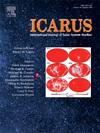基于深度学习的月球南极区H2O冰识别
IF 2.5
2区 物理与天体物理
Q2 ASTRONOMY & ASTROPHYSICS
引用次数: 0
摘要
基于各种远程测量,包括可见光和近红外光谱,已经提出在月球两极附近的永久阴影区(PSRs)存在冷冻挥发物(特别是H2O冰)。与中低纬度地区相比,由于太阳光照较差,PSRs中的近红外光谱信号存在噪声。再加上月球风化层的覆盖和混合效应,用于识别PSRs中H2O冰的VNIR光谱特征有限。深度学习模型作为月球探测领域的新兴技术,能够学习光谱特征和模式,从大数据集中发现复杂的光谱模式和非线性关系,适用于月球高光谱遥感数据和水冰识别任务。本文介绍了一种基于深度学习的一维卷积自编码器模型对水冰的识别结果。在模型应用过程中,轨道光谱仪获得的遥感光谱与先进仪器获得的实验室光谱存在本质差异。针对训练数据有限、实验室光谱与遥感光谱难以匹配的问题,引入自监督学习方法,实现了月球南极地区H2O冰的像素级识别与制图。我们的模型应用于月球矿物绘图仪的二级反射率数据。提取识别出的H2O含冰像元的光谱,利用光谱角映射和峰聚类方法进行双重验证,进一步确认了大部分H2O含冰像元的识别。讨论了月球南极地区H2O冰的光谱特征与晶体结构、晶粒尺寸和混合效应的关系。月球南极地区的水冰倾向于以较小颗粒(~ 70 μm)的形式存在,而2 μm的弱吸收或不存在表明存在异常大的颗粒。晶体冰是确定含冰表面光谱的主要相,但不能排除光学探测深度下存在无定形水冰的可能性。本文章由计算机程序翻译,如有差异,请以英文原文为准。
Identification of H2O ice at lunar south polar region based on deep learning
The presence of frozen volatiles (especially H2O ice) has been proposed in the permanently shadowed regions (PSRs) near the poles of the Moon, based on various remote measurements including the visible and near-infrared (VNIR) spectroscopy. Compared with the middle- and low-latitude areas, the VNIR spectral signals in the PSRs are noisy due to poor solar illumination. Coupled with the lunar regolith coverage and mixing effects, the available VNIR spectral characteristics for the identification of H2O ice in the PSRs are limited. Deep learning models, as emerging techniques in lunar exploration, are able to learn spectral features and patterns, and discover complex spectral patterns and nonlinear relationships from large datasets, enabling them applicable on lunar hyperspectral remote sensing data and H2O-ice identification task. Here we present H2O ice identification results by a deep learning-based model named one-dimensional convolutional autoencoder. During the model application, there are intrinsic differences between the remote sensing spectra obtained by the orbital spectrometers and the laboratory spectra acquired by state-of-the-art instruments. To address the challenges of limited training data and the difficulty of matching laboratory and remote sensing spectra, we introduce self-supervised learning method to achieve pixel-level identification and mapping of H2O ice in the lunar south polar region. Our model is applied to the level 2 reflectance data of Moon Mineralogy Mapper. The spectra of the identified H2O ice-bearing pixels were extracted to perform dual validation using spectral angle mapping and peak clustering methods, further confirming the identification of most pixels containing H2O ice. The spectral characteristics of H2O ice in the lunar south polar region related to the crystal structure, grain size, and mixing effect of H2O ice are also discussed. H2O ice in the lunar south polar region tends to exist in the form of smaller particles (∼70 μm in size), while the weak/absent 2-μm absorption indicate the existence of unusually large particles. Crystalline ice is the main phase responsible for the identified spectra of ice-bearing surface however the possibility of amorphous H2O ice beneath optically sensed depth cannot be ruled out.
求助全文
通过发布文献求助,成功后即可免费获取论文全文。
去求助
来源期刊

Icarus
地学天文-天文与天体物理
CiteScore
6.30
自引率
18.80%
发文量
356
审稿时长
2-4 weeks
期刊介绍:
Icarus is devoted to the publication of original contributions in the field of Solar System studies. Manuscripts reporting the results of new research - observational, experimental, or theoretical - concerning the astronomy, geology, meteorology, physics, chemistry, biology, and other scientific aspects of our Solar System or extrasolar systems are welcome. The journal generally does not publish papers devoted exclusively to the Sun, the Earth, celestial mechanics, meteoritics, or astrophysics. Icarus does not publish papers that provide "improved" versions of Bode''s law, or other numerical relations, without a sound physical basis. Icarus does not publish meeting announcements or general notices. Reviews, historical papers, and manuscripts describing spacecraft instrumentation may be considered, but only with prior approval of the editor. An entire issue of the journal is occasionally devoted to a single subject, usually arising from a conference on the same topic. The language of publication is English. American or British usage is accepted, but not a mixture of these.
 求助内容:
求助内容: 应助结果提醒方式:
应助结果提醒方式:


